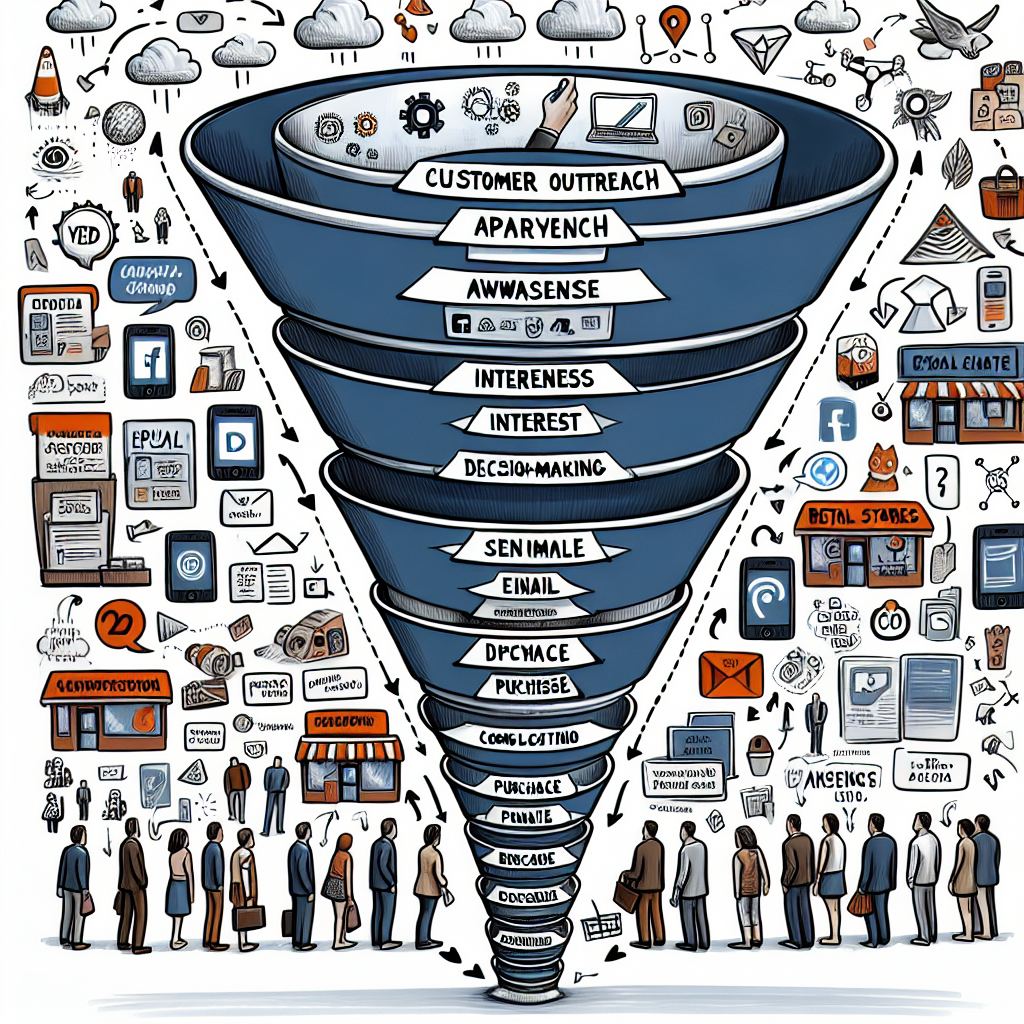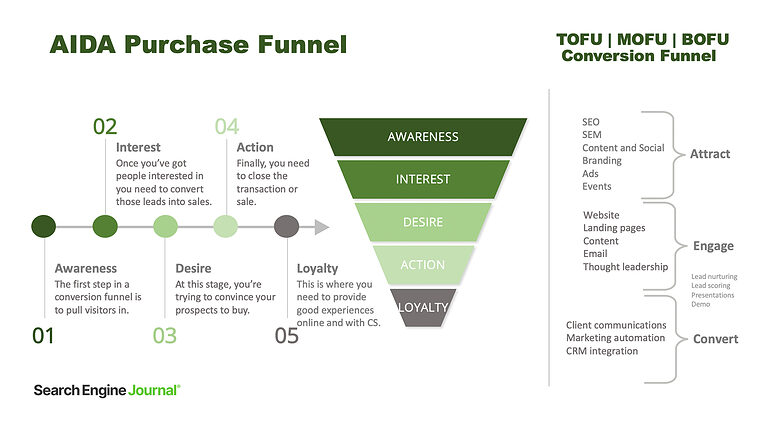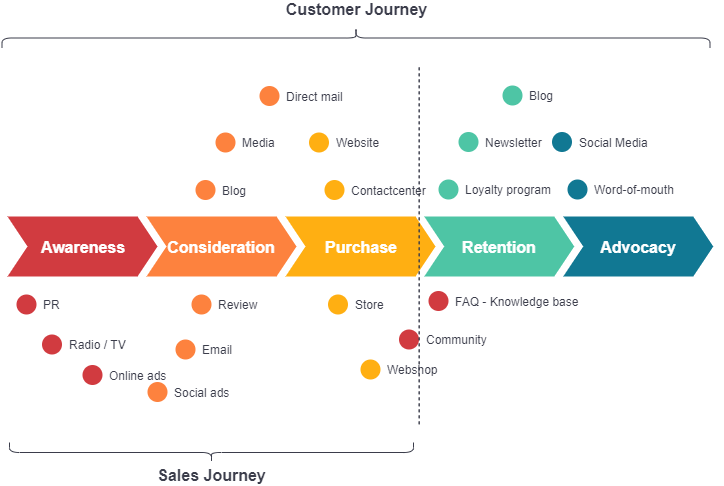Uncover the secrets to crafting the perfect marketing funnel that will transform your customer’s journey from start to finish.

Image courtesy of via DALL-E 3
Table of Contents
Welcome to our guide on optimizing your customer journey through the marketing funnel! In this article, we will explore what a marketing funnel is and why it’s crucial for businesses. By enhancing the customer journey, businesses can increase their chances of success and improve their relationship with customers.
What is a Marketing Funnel?
A marketing funnel is like a path that customers take from first learning about a product or service to eventually making a purchase. Think of it as a journey that customers go through as they interact with a business and its offerings.
Why is Optimization Important?
Optimizing the customer journey is essential because it helps businesses understand their customers better and tailor their strategies to meet their needs. By improving the funnel, businesses can create happier customers who are more likely to make a purchase and become loyal supporters of the brand.
Top of the Funnel (TOFU)
Creating Awareness
At the beginning of the marketing funnel, businesses focus on creating awareness. This means letting people know they exist and what they have to offer. One way businesses do this is through advertisements, which can be seen on TV, social media, or even on billboards. They also use social media platforms like Instagram, Facebook, and Twitter to reach a wider audience. Blog posts are another way businesses share information about themselves and their products. All these tactics help businesses get on people’s radars so they can learn more about them.
Attracting the Right Audience
While creating awareness is important, it’s equally crucial to attract the right audience. Not everyone will be interested in what a business has to offer, so it’s essential to find the people who are. Businesses use various strategies to attract the right audience, such as targeting specific demographics or interests in their advertising. For example, a beauty brand might target young women who are interested in skincare and makeup. By attracting the right audience, businesses can increase the chances of converting them into customers later in the funnel.
Middle of the Funnel (MOFU)
After attracting the attention of potential customers at the top of the funnel, businesses move on to the Middle of the Funnel (MOFU) where they focus on educating and building trust with those who have shown interest. This stage is crucial in guiding potential customers towards making a decision to purchase.
Educating Potential Customers
At the MOFU stage, businesses provide valuable information to help potential customers learn more about their products or services. This can include detailed product descriptions, how-to guides, case studies, or comparison charts. By offering relevant and helpful content, businesses can address the questions and concerns of potential customers, ultimately positioning themselves as knowledgeable and trustworthy sources.
Building Trust
Building trust is essential in the MOFU stage as it plays a significant role in influencing a potential customer’s decision-making process. Businesses can establish trust by being transparent, providing honest information, and showcasing social proof such as customer testimonials or reviews. By consistently delivering on promises and offering exceptional customer service, businesses can instill confidence in potential customers, making them more likely to move further down the marketing funnel towards making a purchase.
Bottom of the Funnel (BOFU)
Now that you’ve learned about the different stages of the marketing funnel, let’s dive into the last part – the Bottom of the Funnel (BOFU). This is where businesses focus on encouraging people to make a purchase. One crucial aspect of this stage is making the decision-making process easy for potential customers.
Image courtesy of www.owox.com via Google Images
Businesses can simplify the purchasing decision for customers by offering discounts, special promotions, or guarantees. These incentives can help sway a hesitant buyer towards making a purchase. By providing clear information about pricing, features, and benefits, businesses can make it easier for customers to understand the value they will receive.
Closing the Sale
Another important aspect of the BOFU is closing the sale. This involves using different strategies to seal the deal and convert potential customers into paying ones. One effective way to close the sale is by following up with customers who have shown interest in the product or service.
Businesses can send personalized emails, make phone calls, or even offer additional assistance to address any remaining concerns or questions customers may have. By providing excellent customer service and maintaining communication with leads, businesses can increase the likelihood of turning them into loyal customers.
Analyzing Your Funnel
When it comes to optimizing your marketing funnel, the first step is to take a closer look at how it’s performing. By analyzing the various stages of your funnel, you can identify areas that may need improvement and make informed decisions to enhance the overall customer journey.
Tracking Metrics
Metrics are like measuring tools that help you understand how well your funnel is working. It’s important to keep track of key indicators like the number of people visiting your website, how many of them are taking the next step, and where they might be dropping off.
By analyzing these metrics, you can gain valuable insights into customer behavior and pinpoint areas that may need adjustment. For example, if you notice a high drop-off rate at a particular stage of the funnel, it might indicate a need for improvement in that area.
Finding Weak Spots
Identifying weak spots in your funnel is crucial for optimization. These are points where potential customers are getting stuck or losing interest, leading to a decrease in conversions. By finding and addressing these weak spots, you can streamline the customer journey and make it more efficient.
One way to find these weak spots is by analyzing the customer journey from start to finish. Look for any bottlenecks or areas where customers may be experiencing confusion or resistance. Once you’ve identified these problem areas, you can develop targeted strategies to fix them and improve overall funnel performance.
Improving Each Funnel Stage
At the top of the funnel, it’s all about grabbing people’s attention. One simple way to enhance this stage is by creating engaging content that speaks to your target audience. This could be through eye-catching social media posts, informative blog articles, or captivating ads. By understanding what appeals to your potential customers, you can tailor your content to attract them to your business.

Image courtesy of www.searchenginejournal.com via Google Images
Enhancing MOFU
As potential customers move into the middle of the funnel, it’s essential to educate them about your product or service. One strategy to enhance this stage is by providing valuable information that helps them make informed decisions. This could involve creating detailed product guides, offering demos or tutorials, or sharing customer testimonials. By building trust through informative content, you can guide customers towards a purchase.
Enhancing BOFU
When customers reach the bottom of the funnel, it’s time to close the deal. To enhance this stage, businesses can make it easier for customers to make the final decision. Offering incentives like discounts, free trials, or money-back guarantees can help alleviate any last-minute doubts. Additionally, providing excellent customer service and follow-up support can reassure customers and nudge them towards making a purchase.
Tools to Optimize Your Funnel
When it comes to optimizing your marketing funnel, having the right tools and software can make a significant difference in improving customer journey and driving conversions. Here are some essential tools that can help you maximize the effectiveness of your funnel:
Popular Funnel Tools
1. Email Marketing Platforms: Tools like Mailchimp, Constant Contact, or ConvertKit can help you create and automate email campaigns to nurture leads throughout the funnel.
2. CRM Software: Customer Relationship Management software such as Salesforce or HubSpot can track customer interactions and help you personalize your marketing efforts.
3. Analytics Tools: Google Analytics or Hotjar can provide valuable insights into how users are interacting with your website and where they may be dropping off in the funnel.
4. Landing Page Builders: Tools like Unbounce or Leadpages can help you design and optimize landing pages to capture leads effectively.
5. Social Media Management Platforms: Platforms like Hootsuite or Buffer can help you schedule posts, engage with your audience, and drive traffic to your funnel.
Choosing the Right Tool
When selecting tools to optimize your funnel, it’s essential to consider your specific business needs and goals. Here are some factors to keep in mind:
1. Features: Look for tools that offer the features you need to support each stage of your funnel, from awareness to conversion.
2. Integration: Choose tools that can seamlessly integrate with your existing systems to ensure a smooth workflow and data sharing.
3. Price: Consider your budget and the overall value the tool can provide to your business in terms of ROI.
4. Support: Opt for tools that offer reliable customer support and resources to help you make the most out of their features.
By leveraging the right tools and software, you can streamline your funnel optimization process, track key metrics more effectively, and ultimately enhance the overall customer journey to drive better results for your business.
Real-Life Examples
Let’s take a look at a small business, a local bakery, that successfully optimized its marketing funnel. The bakery started by creating awareness through local flyers and social media posts showcasing their delicious pastries and cakes. This led to attracting the right audience of food lovers in the community.

Image courtesy of online.visual-paradigm.com via Google Images
As potential customers moved to the middle of the funnel, the bakery focused on educating them about their unique baking techniques and quality ingredients. By offering free samples and hosting baking classes, they built trust with their customers and established a loyal following.
When it came to the bottom of the funnel, the bakery made the decision easy for customers by offering special promotions for bulk orders and personalized birthday cakes. Their attentive customer service and quick follow-ups ensured a high conversion rate, with many customers becoming repeat buyers.
Big Company Example
Now, let’s turn our attention to a big company, an online retail giant, that revamped its marketing funnel strategy. The company began by investing heavily in creating awareness through targeted online ads and influencer partnerships, reaching a vast audience of potential shoppers.
As customers moved to the consideration stage, the company focused on educating them about the wide range of products available through detailed product descriptions, reviews, and how-to guides. By providing valuable information, they helped customers make informed decisions.
At the decision stage, the company implemented personalized recommendations based on customer browsing history and shopping cart reminders to nudge hesitant buyers towards making a purchase. By offering hassle-free returns and excellent customer support, they successfully closed the sale and increased customer satisfaction.
Conclusion
In conclusion, optimizing the marketing funnel is essential for businesses to succeed in today’s competitive market. By understanding the customer journey and strategically guiding them through the different stages of the funnel, companies can increase customer satisfaction and drive more conversions. It is crucial to create awareness, educate potential customers, and make the decision-making process as smooth as possible to encourage purchases.
Throughout this guide, we have explored the importance of each stage of the funnel – from the top, where businesses attract and engage potential customers, to the bottom, where the focus is on closing sales. By analyzing key metrics and identifying weak spots, businesses can make informed decisions to enhance the effectiveness of their funnel.
Remember, the goal of optimizing the marketing funnel is to create a seamless and enjoyable experience for customers, ultimately leading to increased sales and customer loyalty. By implementing the strategies and tools outlined in this guide, businesses can refine their approach and maximize the potential of their marketing efforts.
It’s time to take action and start optimizing your marketing funnel. By continually evaluating and improving your strategies, you can ensure long-term success and growth for your business. Now that you have the knowledge and tools to optimize your customer journey, it’s up to you to put them into practice and see the results for yourself. Good luck!
Want to turn these SEO insights into real results? Seorocket is an all-in-one AI SEO solution that uses the power of AI to analyze your competition and craft high-ranking content.
Seorocket offers a suite of powerful tools, including a Keyword Researcher to find the most profitable keywords, an AI Writer to generate unique and Google-friendly content, and an Automatic Publisher to schedule and publish your content directly to your website. Plus, you’ll get real-time performance tracking so you can see exactly what’s working and make adjustments as needed.
Stop just reading about SEO – take action with Seorocket and skyrocket your search rankings today. Sign up for a free trial and see the difference Seorocket can make for your website!
Frequently Asked Questions (FAQs)
What is a marketing funnel?
A marketing funnel is like a journey that customers take from first learning about a product or service to finally making a purchase. It’s called a funnel because, just like pouring liquid into a funnel, many people start at the top, but only a few end up making a purchase at the bottom.
Why is it important to optimize my funnel?
Optimizing your marketing funnel is crucial for the success of your business. By making your funnel better, you are making it easier for customers to move through the stages of the funnel, making them happier and more likely to buy from you. This can lead to more sales and growth for your business.
How do I know if my funnel is working?
To determine if your marketing funnel is working effectively, you can track certain metrics. These metrics can include things like the number of people visiting your website, the percentage of visitors who sign up for your newsletter, or the number of people who eventually make a purchase. By monitoring these metrics, you can see where customers might be getting stuck in the funnel and make improvements to help them move through more smoothly.







